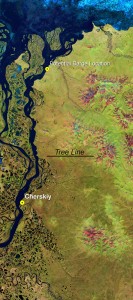Following our Polaris Retreat and Arctic Field Class, plans for the 2014 expedition are falling into place, and the excitement is building for our group’s next meeting at JFK airport when we depart for Siberia.
The purpose of all this planning is to facilitate student research on arctic ecosystems. As a climate change ecologist, I feel there is nowhere else on Earth that is a more critical area of study than the Arctic. And the only way to gain a more complete knowledge of arctic ecosystems, where climate-driven changes are already underway, is to bring in a new generation of scientists to build on current knowledge by exploring new areas, asking new questions, and making new connections.

Greg Fiske prepared this Satellite image (Landsat 8) showing the tundra area where we will be focusing the Core research this summer.
This is exactly what we are hoping to do this summer. The 2014 expedition is especially exciting for the Polaris Core group, because for the first time, we will focus our research efforts north of the tree line, at a tundra site situated just 20 km from the Arctic Ocean.
We will travel by barge 90 km from the Northeast Science Station in Cherskii, Russia down the Kolyma River to our tundra field site, where we will live and work for two weeks. By expanding our research to the tundra, we will be better able to understand linkages between ecosystems and landscape components and strengthen our ability to scale up to larger areas, such as the Kolyma watershed.
We are very excited to see what observations and questions the Core students generate as they explore this unfamiliar landscape. Here are some possible questions we may address with our research:
• How much carbon is stored in the tundra–in thawed soil, in permafrost, and in plants? How does this compare to taiga regions
• How does the amount and composition of carbon and nutrients change as they are transported across and between terrestrial and aquatic ecosystems?
• How vulnerable are tundra carbon pools to decomposition?
• What is the form of carbon released to the atmosphere–methane (CH4) or carbon dioxide (CO2)–and how does this change across the landscape?
• What are the biological and environmental drivers of CO2 and CH4 fluxes?
• How do different ecosystem components (vegetation, soil, microbes, permafrost, physical environment) interact, and how do these interactions control carbon and nutrient uptake, loss, transport, transformation?
We will be talking a lot more about these processes and how we study them as our expedition unfolds. Stay tuned.
